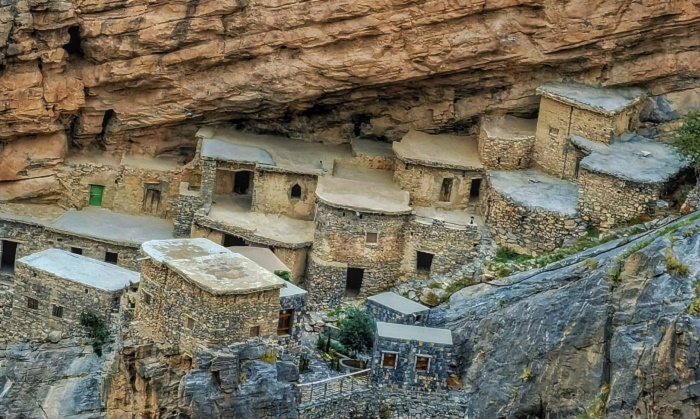
Jabal Akhdhar is already known for its grand peaks, mysterious canyons and terraced farms, but the iconic villages that date back over two hundred years, still take the breath away of many travellers, including international town planning experts.
British architect Martin Bailey, who has been designing accommodations for over thirty five years, finds the construction of old houses in the villages ‘intriguing.’
“The fact that these old houses are still standing is a tribute to old Omani engineers who built them. The houses in Wadi Habib and Al-Ayn, to take examples of just two villages, are at least 150 years old. It is not the just the old technology used that I find intriguing but the craftsmanship of using a combination of woods, bricks and plaster, is a masterpiece and work of art, even in the world of today,” said Mr Bailey, a 68-year old retired architect based in Manchester, England.
The villages are located on the tallest peaks of Jabal Akhdhar, where pomegranates, olives, apricots, grapes, pears, plums, peaches and raspberries grow. In the spring months, even gardens of roses flourish there. But not only are the architects impressed, but also the tourists looking to feast their eyes on the beauty around them, are fascinated by the enchanting villages that are still intact against the ravages of time.
Hugo Veran, a 36-year old French school teacher, said the villages of the Jabal Akhdhar have mystical beauty and endless charms that made him come back twice to see them again.
“I cannot get enough of their beauty, mystery and charms that never end. I came here for the first time last September and I am here again this month of February. The houses are so old but reasonably preserved for us to come here and enjoy more than a century later,” Veran, who is in Oman on a week holiday, told Times of Oman.
To many tourists, Jabal Akhdhar is like a magic box that has endless charms and mystical beauty that never cease to amaze them and according to hotel managers, villages are a top attraction to the guests.
“The visit to the villages are a top attractions for our guests. Then comes the canyon viewing, trekking, hiking and mountain climbing. Why? Because most of the guests like to take away a piece of history in their minds, not just the activities. Our guests are also journalists who go back to their countries to write about these old habitats and the way people used to live more than a hundred years ago,” Greg Dsouza, Director of Sales and Marketing for DusitD2 Hotel, told Times of Oman.
The hotel, which was opened last summer, is owned by Omran, the Omani government’s arm for tourism development and investments. The massive 300-plus rooms accommodation, is located near all attractions, including the beautiful villages of Al-Ayn and Aqar.
What is the real story about these beautiful villages that still stand today?
Times of Oman caught up with one of the descendants who told the story of one of the most visited villages his family built on the edge of a cliff.
“Over 120 years ago, my family built the Wadi Bani Habib village and it started with only one accommodation. Years later, as the family grew, they built more houses. They were farmers and they chose the location because of the wadi to water the farms. They also reared animals. To build these houses, they carved each brick from rocks, made woods from trees around them and used mud from the wadi for plastering walls,” Yusuf Al-Habib, a descendant from a long-line of the family, told Times of Oman.
A visitor sitting on the top of a mountain can see below villages like Al-Ayn and Al-Aqar hugging the edge of a mountain. They are surrounded by formidable rocks that shelter villagers from strong winds. One can hear faint screams of children playing on the terraced farms where villagers grow their food.
“I cannot get enough of this view,” said 44-year old Rose Almeida, a Portuguese expatriate working in Muscat, “I come here every day just to sit here and watch the old houses below me. It is so peaceful and at the same time mind boggling. It is like time has stood still for the villagers who are living there.”